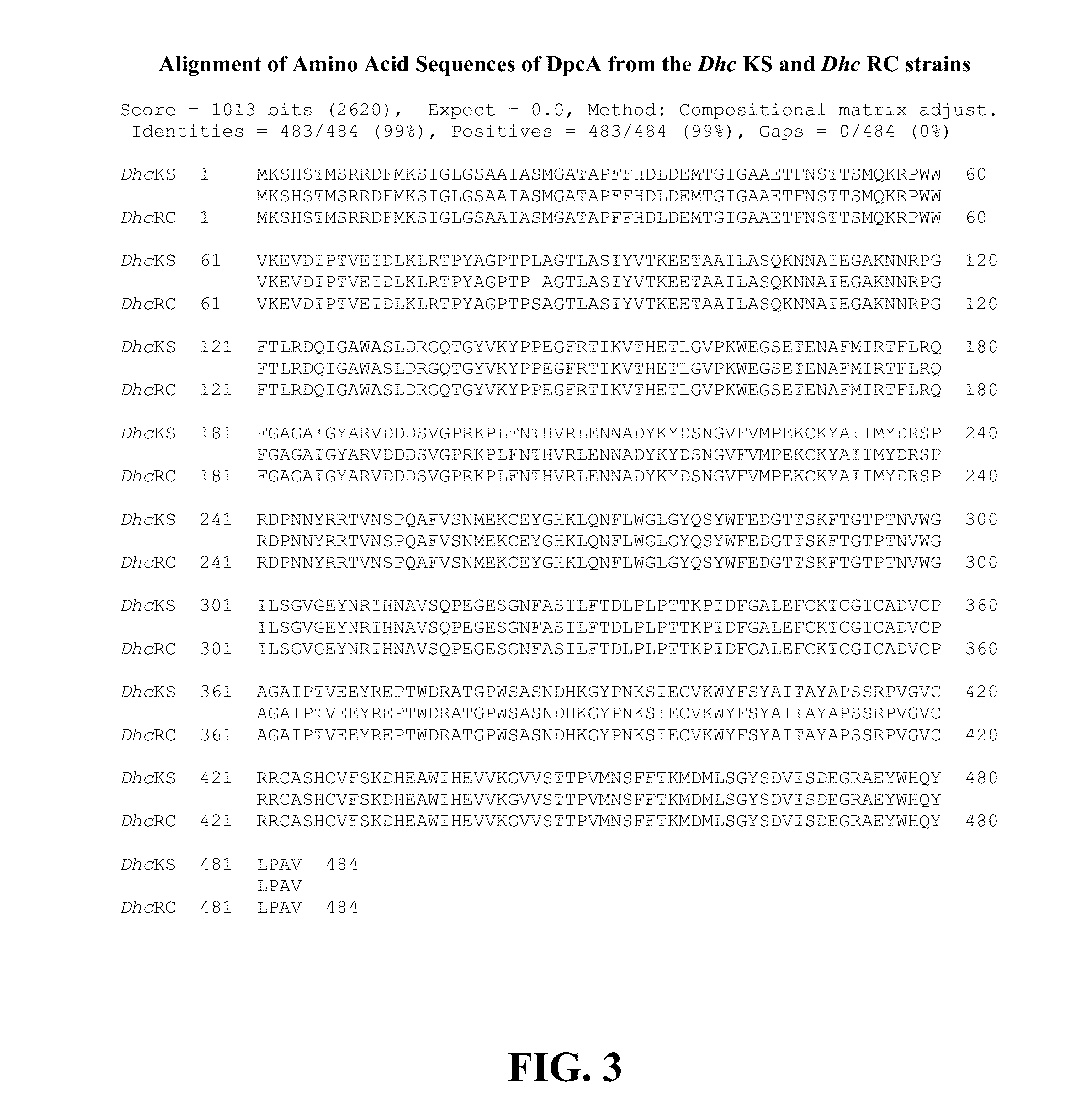1, 2-Dichloropropane-to-Propene Reductive Dehalogenase Genes
a technology of dichloropropane and reductive dehalogenase, which is applied in the field of new 2dichloropropanetopropene reductive dehalogenase genes, can solve the problem that the total amount of actual discharge into the environment is likely to exceed the epa's estima
- Summary
- Abstract
- Description
- Claims
- Application Information
AI Technical Summary
Benefits of technology
Problems solved by technology
Method used
Image
Examples
example 1
Isolation of 1,2-Dichloropropane Dechlorinating Cultures
[0087]The 1,2-dichloropropane dechlorinating cultures Dehalococcoides (Dhc) mccartyi strain RC and strain KS were derived from the Red Cedar River near Okemos, Mich., and the King Salmon River, Ak., respectively (Löffler, F. E., et al (1997) Appl. Environ. Microbiol. 63:2870-2875; Ritalahti, K. M., and F. E. Löffler (2004) Appl. Environ. Microbiol. 70:4088-4095). The Red Cedar River has no known anthropogenic sources of chlorinated solvents but is located in an agricultural area. The King Salmon River sediment had reported hydrocarbon contamination. Both cultures are non-methanogenic and have been maintained in reduced mineral salts medium (Löffler, F. E., et al (1997) Appl. Environ. Microbiol. 63:2870-2875; Ritalahti, K. M., and F. E. Löffler (2004) Appl. Environ. Microbiol. 70:4088-4095) for more than 10 years. Briefly, the cultures were grown in 160 mL serum bottles containing 100 mL of defined, completely synthetic reduced ...
example 2
Preparation of cDNA from 1,2-Dichloropropane Dechlorinating Cultures
[0088]Biomass was collected from 10-20 mL of culture suspensions from each of the RC and KS cultures described in Example 1, and the cells were harvested by vacuum filtration onto a Durapore hydrophilic polyvinylidene fluoride membrane (25 mm diameter and 0.22 μm pore size) (Millipore, Billerica, Mass.). RNA extraction, cDNA synthesis and purification were performed as described previously (Ritalahti, K. M., et al. (2010) In K. N. Timmis (ed.), Handbook of Hydrocarbon and Lipid Microbiology. Springer Berlin Heidelberg 32:3671-3685). Briefly, RNA was extracted following the TRIzol Max Bacterial RNA Isolation Kit protocol (Invitrogen, Carlsbad, Calif., USA) provided by the manufacturer. To assess transcript loss, 1×1011 luciferase mRNA molecules were added (Promega, Madison, Wis., USA) before the lysis step as an internal standard to account for RNA loss during extraction, reverse transcription, DNase treatment and cD...
example 3
Reductive Dehalogenase Genes from cDNA Isolated from 1,2-Dichloropropane Dechlorinating Cultures
[0090]One tenth of the final 20 μL volume of cDNA (prepared as described in Example 2) was used as a template for PCR with primers RRF2 (SEQ ID NO: 11) and B1R (SEQ ID NO: 12), which are degenerate primers for reductive dehalogenase genes (Krajmalnik-Brown, R., et al. (2004) Appl. Environ. Microbiol. 70:6347-6351). The PCR amplicons (approximately 1,500 bp) were resolved by electrophoresis on a 1% (wt / vol) agarose gel prepared with TAE buffer (40 mM Tris base in 20 mM acetic acid, 1 mM EDTA, pH 8.5) and stained with ethidium bromide (1 μg / mL). A picture of the PCR amplicons on the agarose gel is shown in FIG. 1. As explained above, all of the PCR reactions were performed with the B1R and RRF2 degenerate PCR primers. Lanes 1-3 of FIG. 1 correspond to samples from Dhc mccartyi strain RC cultures, and lanes 4-6 correspond to samples from Dhc mccartyi strain KS cultures. Lanes 1 and 4 are “no...
PUM
| Property | Measurement | Unit |
|---|---|---|
| pH | aaaaa | aaaaa |
| length | aaaaa | aaaaa |
| length | aaaaa | aaaaa |
Abstract
Description
Claims
Application Information
 Login to View More
Login to View More - R&D
- Intellectual Property
- Life Sciences
- Materials
- Tech Scout
- Unparalleled Data Quality
- Higher Quality Content
- 60% Fewer Hallucinations
Browse by: Latest US Patents, China's latest patents, Technical Efficacy Thesaurus, Application Domain, Technology Topic, Popular Technical Reports.
© 2025 PatSnap. All rights reserved.Legal|Privacy policy|Modern Slavery Act Transparency Statement|Sitemap|About US| Contact US: help@patsnap.com



